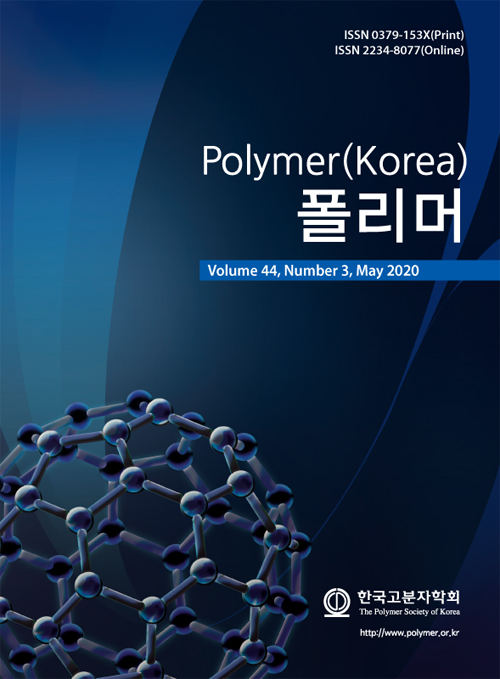- Preparation and Properties of Eco-friendly Polyurethane Nanocomposites Using Cellulose Nanocrystals with Amino Group as Fillers
Department of Chemical Engineering, Keimyung University, Daegu 42601, Korea
- 아미노기가 도입된 셀룰로오스 나노 결정을 충전제로 사용한 친환경 폴리우레탄 나노복합체 제조 및 물성에 대한 연구
계명대학교 공과대학 화학공학과
In this study, a polyol
mixture of bio-polyol and petroleum-polyol in a mass ratio of 3:7 was reacted
with 4,4'-methylenebis(phenyl isocyanate) (MDI) to prepare an eco-friendly
polyurethane (PU) nanocomposite. Also, using 3-aminopropyltriethoxysilane (APS)
silane coupling agent, -NH2 group was grafted onto the cellulose
nanocrystals (CNCs) surfaces, which was used as fillers. We studied the effects
of surface modified CNC fillers on the mechanical properties of PU
nanocomposites using thermogravimetric analysis (TGA), universal testing
machine (UTM) and dynamic mechanical analyzer (DMA). The -NH2 groups
grafted on the CNC surface can form urea bonds with -NCO groups of MDI at the
interface, which increased the tensile strength and modulus of PU
nanocomposites more than those of the pristine CNC as fillers.
본 연구에서는 바이오 폴리올과 석유계 폴리올을 질량비 3:7 비율로 혼합한 폴리올을 4,4'-methylenebis (phenyl
isocyanate)(MDI)와 반응시켜 친환경 폴리우레탄 나노복합체를 제조하는 연구를 수행하였다.
또한 3-amino-propyltriethoxysilane(APS) 실란 커플링제를 사용하여, 셀룰로오스 나노 결정(cellulose nanocrystal, CNC) 표면에 -NH2기를 도입하여 충전제로 사용하였다. 표면 개질된 CNC 충전제가 폴리우레탄 나노복합체의 물성에 미치는 영향을 열 중량 분석기(TGA),
만능재료시험기(UTM) 및 동적기계분석기(DMA)를
사용하여 체계적으로 분석하였다. CNC 표면에 도입된 -NH2기는 MDI의 -NCO기와 계면에서 우레아 결합을 형성하여 순수 CNC를 충전제로 사용한 폴리우레탄 나노복합체보다 인장강도와 탄성률이 더 많이 증가되는 것을 확인하였다.
Keywords: cellulose nanocrystal (CNC), silane coupling agent, 3-aminopropyltriethoxysilane (APS), polyurethane, bio-polyol
- Polymer(Korea) 폴리머
- Frequency : Bimonthly(odd)
ISSN 0379-153X(Print)
ISSN 2234-8077(Online)
Abbr. Polym. Korea - 2023 Impact Factor : 0.4
- Indexed in SCIE
 This Article
This Article
-
2020; 44(3): 397-407
Published online May 25, 2020
- 10.7317/pk.2020.44.3.397
- Received on Mar 3, 2020
- Revised on Mar 23, 2020
- Accepted on Mar 25, 2020
 Correspondence to
Correspondence to
- KiRyong Ha
-
Department of Chemical Engineering, Keimyung University, Daegu 42601, Korea
- E-mail: ryongi@kmu.ac.kr










 Copyright(c) The Polymer Society of Korea. All right reserved.
Copyright(c) The Polymer Society of Korea. All right reserved.